
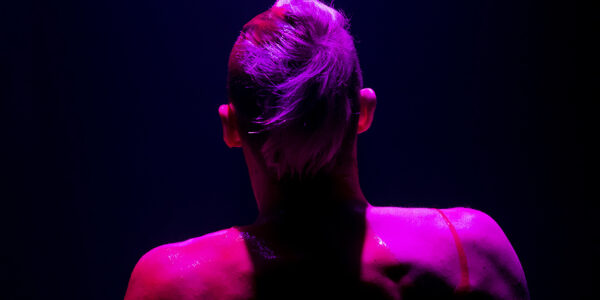
The Horn of Plenty by Maison the Faux with Han Li
When design talent Han Li linked up with design studio Maison the Faux to collaborate on the spatial design for the project The Horn of Plenty, she was jumping onto a moving train. This ‘hyper-sensory performance’, where food, performers and an extraordinary lighting and set design are intertwined, had in fact already started in May 2021 with a short residency at the Nieuwe Oost theatre in Arnhem. In November 2021, Han Li was matched to the project through the Creative Industries Fund NL’s Building Talent programme. The basis for her task of devising a spatial elaboration was laid during those two weeks of residency. It was her task to contribute ideas about the further development of the foundation that had been laid during the residency.
It was not the best time for an intensive collaboration: the Covid measures were strict, and mutual communication took place mainly online. In addition, there was still the problem of the language: design language to be precise. Li studied architecture in Delft. Tessa de Boer and Joris Suk’s design studio Maison the Faux came into being shortly after their studies at the ArtEZ fashion academy in Arnhem.
Li: ‘In architecture, it’s normal to brainstorm for a long time, to explore all the possibilities on paper before you actually start working.’
De Boer: ‘We start pretty much on the other side. Very focused on the material aspects, very... tactile. Great ideas, was what I thought when I saw Han Li’s proposals, but it’s ‘just on paper, it’s not alive yet. When are you going to bring it to life?’
Li: ‘“Life”? is what I thought then – what do you mean by “life”? And then Tessa came up with a mood board with fabrics and images that I couldn’t always feel because we weren’t in the same room.’
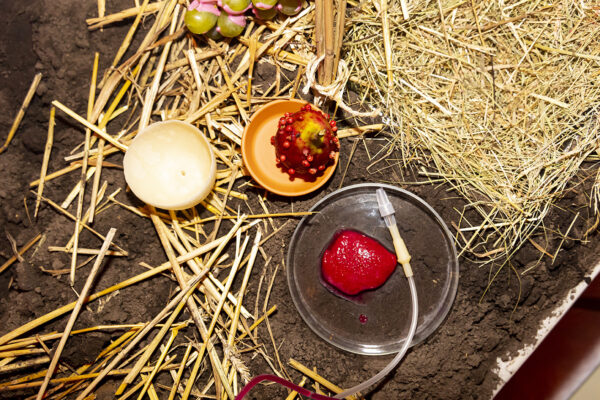

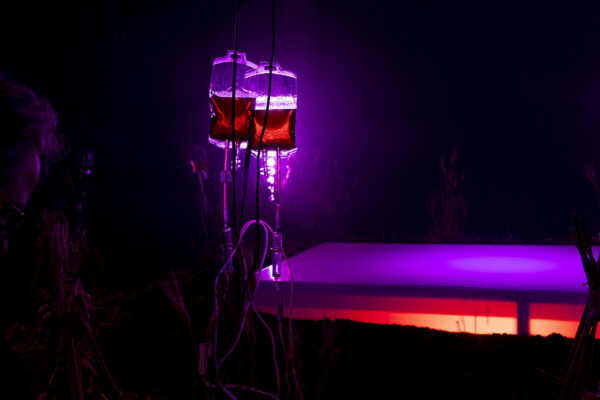
the core
No one gave up. Han Li continued to work on the spatial concept, while in the meantime the actual performance was being tinkered with together with food designer Katja Gruijters and performer Arno Verbruggen.
De Boer: ‘The performance came from the need to do more with food and art. We wanted to explore abundance and impermanence. We wondered whether life is actually circular and if so, how? Pretty big questions, which we answered very much with the senses: with blood, earth, naked bodies.’
Li: ‘It was interesting to watch Maison the Faux work with the others. I was allowed to participate in the thinking from the beginning, and I tried to get on board. For example, I came up with a conveyor belt on which the food could slide by, because the audience sits ‘at’ the stage on which the performance is taking place, so the food would pass right in front of them.’
De Boer: ‘We thought a conveyor belt was cool, but it did immediately raise two questions. The first was: why would you do it? And the second was: where do we find a conveyer belt like that? This is maybe a good example of the practical way we work. We start with a concept, we definitely have a goal with what we are doing, but the step between concept and elaboration is quite small. For example, we wanted to explore the circularity of life. The basis of that life is the earth. We then wanted to have that earth on the floor but also on the stage. The next question is: What kind of earth is that? Is it compost, sand, potting soil, edible soil? Suppose it is edible soil, what could food designer Katja do with it? And on we go!’
Li: ‘I’ve discovered that when I see other people’s ideas, I tend to drift off first, sometimes in a completely different direction. So, after a meeting, I would develop plans that had come out of that meeting, but had taken on a life of their own. That happened several times in the process and it didn’t work well. Again and again, I had to search for the core of the performance through my own detours.’
I’ve discovered that when I see other people’s ideas, I tend to drift off first, sometimes in a completely different direction. (...) Again and again, I had to search for the core of the performance through my own detours. – Han Li
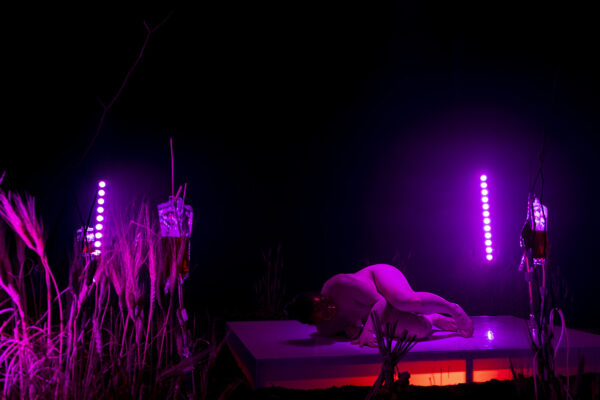

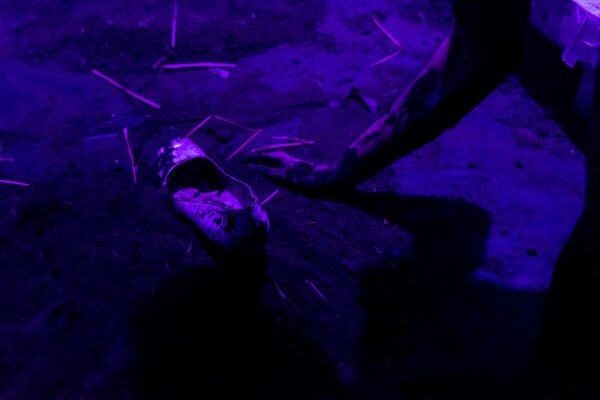
You see, we come from the core and zoom out, while Han Li starts from a broad perspective and then looks for the core. Turns out there’s always a point halfway where you meet up with each other – Tessa de Boer
hay
There was no conveyer belt. However, Li did, among other things, start working on the seats for the public. Benches made of hay with a plastic belt around them and an MDF board on top. ‘How it sits and feels, that’s what I investigated.’
De Boer: ‘That’s how we managed to move further. Looking back, I think we may have been stuck in that exploratory phase a little too long, but that also had to do with Covid. If you have two different backgrounds, it is much more enjoyable to be in one room together. The few times we did that it immediately worked much more smoothly – but of course, it often wasn’t possible.’
In March, there was a try-out performance of The Horn of Plenty in Arnhem. Featuring Han Li’s benches, food designer Katja Gruijters, chef Eric Meursing, and four performers: Arno Verbruggen, Jordan Achiano, Robin Nimanong and Żaneta Kęsik. Diamanda Dramm was the sound designer. The audience was asked for their opinion afterwards and they proved to be intrigued by the intentions of the makers and by the unusual food that they sometimes hardly dared to touch because of its strangeness. The try-out and the follow-up discussion provided enough material to build on, as the ‘real’ performance is scheduled for September, at the Felix Meritis theatre in Amsterdam. Whether Li will also be involved in the further development has not yet been discussed together.
Li: ‘I have learned a lot from this process. I also understood better and better what the question was. If I had to sum up the collaboration in three words, I’d choose, um ... challenging, productive and ... let me think.’
De Boer: ... dirty!’
Li: ‘That’s right, dirty!’
De Boer: ‘That's because of the earth, and that sticky jelly on the performers. I think these are well-chosen words, and I agree totally. You see, we come from the core and zoom out, while Han Li starts from a broad perspective and then looks for the core. Turns out there’s always a point halfway where you meet up with each other.’
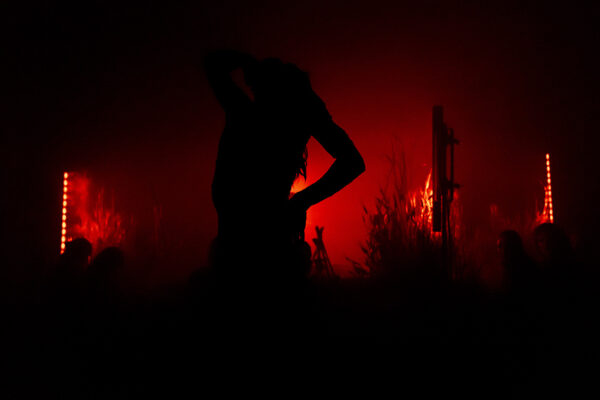

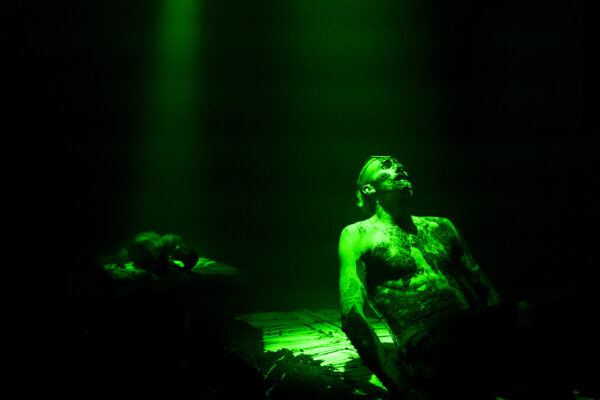
In September, The Horn of Plenty can be seen at the Felix Meritis theatre in Amsterdam. For more info, keep an eye on the Maison the Faux website.
Text: Jowi Schmitz






